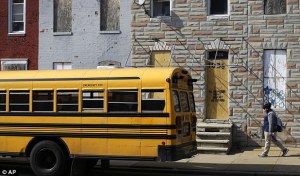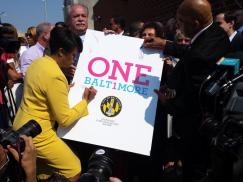 Following the death of Freddie Gray, the need for more and more meaningful work as an antidote to injustice in Baltimore has become a rallying cry. Caroline Center reflects on one aspect of the issue in The Breakroom.
Following the death of Freddie Gray, the need for more and more meaningful work as an antidote to injustice in Baltimore has become a rallying cry. Caroline Center reflects on one aspect of the issue in The Breakroom.
A new study by Raj Chetty and Nathaniel Hendren, which was released in May 2015, identifies Baltimore City as one of the worst places in the country for helping children who are living in poverty move up the income ladder as adults.
In fact, Baltimore is near the very top of the worst places list, “ranking 15 out of 2,478 counties, better than almost no county in the nation.” Prospects for upward mobility for children whose families are experiencing poverty are bleak, with future earning potential for young men being far less than it is for young women.
The study, “The Impacts of Neighborhoods on Inter-generational Poverty,” estimates that for all children growing up impoverished in Baltimore City, future income will be eroded by as much as $4,510 annually, 17% below the national average. At age 26, young men who  grew up in poverty in Baltimore City will earn about $6,830 less each year and young women will earn about $1,490 less each year than their economic peers in other cities and counties across the U.S. Even more revealing, the study indicates that not only does place matter greatly in its ability to affect one’s “income mobility,” but that every year of childhood lived in a particular place matters, too.
grew up in poverty in Baltimore City will earn about $6,830 less each year and young women will earn about $1,490 less each year than their economic peers in other cities and counties across the U.S. Even more revealing, the study indicates that not only does place matter greatly in its ability to affect one’s “income mobility,” but that every year of childhood lived in a particular place matters, too.
Impoverished children whose families are able to move from Baltimore City to Baltimore County or Howard County, for example, when they are 10 years old will have better earning and other life outcomes, even if their financial situations do not improve, than if they moved when they are 15 years old. New York Times Op-Ed Columnist Paul Krugman, who cites the new study, observes that if you are poor or lower-income, you’re better off not living in Baltimore City.  The younger you are when you move to a surrounding area, “the better you will do on average. Children who move at earlier ages are less likely to become single parents, more likely to go to college and more likely to earn more.”
The younger you are when you move to a surrounding area, “the better you will do on average. Children who move at earlier ages are less likely to become single parents, more likely to go to college and more likely to earn more.”
There are so many factors to consider in addressing the root causes of poverty and the ways to eliminate poverty’s persistent and pervasive injustices. It’s complicated, and I’m nowhere near an expert. But, this new study has broadened my thinking on how narrow the financial margins are – how little room there really is for error – and, how unforgiving and treacherous the place where you live can be when you’re just trying to put one foot in front of the other – just trying to reach the next rung on the ladder.
 At Caroline Center, we work hard to make sure that every woman who is experiencing poverty can have an education and skills training that will allow her to step away from unemployment and low wages into a sustainable career with the opportunity for advancement. And, according to a recent Jacob-France Institute report, we are succeeding. The good news is that better than ninety-seven percent of women who graduated from Caroline Center in April 2013 are currently employed in the healthcare professions for which Caroline Center educated them. The other good news is that these graduates’ median quarterly earnings nearly doubled – from $2,724 to $5,475. But, if you do the math, the not-so-good news is that most Caroline Center graduates are working, trying to live and raise their families on just under $22,000 a year.
At Caroline Center, we work hard to make sure that every woman who is experiencing poverty can have an education and skills training that will allow her to step away from unemployment and low wages into a sustainable career with the opportunity for advancement. And, according to a recent Jacob-France Institute report, we are succeeding. The good news is that better than ninety-seven percent of women who graduated from Caroline Center in April 2013 are currently employed in the healthcare professions for which Caroline Center educated them. The other good news is that these graduates’ median quarterly earnings nearly doubled – from $2,724 to $5,475. But, if you do the math, the not-so-good news is that most Caroline Center graduates are working, trying to live and raise their families on just under $22,000 a year.
 At Caroline Center, we remain concerned advocates for a healthier minimum wage, for pay equity, and for employment policies that reflect the value of the contributions that women make in the workplace and that respect every woman’s ability to compete in the marketplace. In doing all of these things, we hope to make individual women’s lives better, create stronger families and communities, and help build a more economically sound city – a city not only with ladders of opportunity, but with ladders that have strong, reachable rungs leading to success.
At Caroline Center, we remain concerned advocates for a healthier minimum wage, for pay equity, and for employment policies that reflect the value of the contributions that women make in the workplace and that respect every woman’s ability to compete in the marketplace. In doing all of these things, we hope to make individual women’s lives better, create stronger families and communities, and help build a more economically sound city – a city not only with ladders of opportunity, but with ladders that have strong, reachable rungs leading to success.
Clearly, getting there will take all of us working together. Policies, legislation, and slogans will only get Baltimore so far. Mayor Stephanie Rawlings- Blake’s ONE BALTIMORE may be a good first step; but, we will need a whole lot of empathy, energy, and enlightenment – and, let’s not forget employment – to get us the rest of the way.

